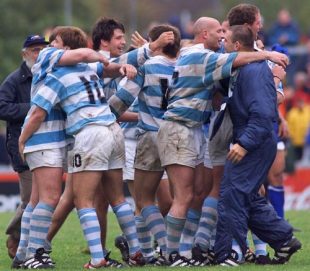|
Comment
Stradey Park set for final bow
Huw Richards
October 17, 2008

The sun will finally set on the historic Stradey Park in Llanelli later this month
© Getty Images
Enlarge
Too bad that Stradey Park should be closing on Friday 24th October with an EDF Anglo-Welsh Cup tie against Bristol. There's nothing unbecoming in the fixture - Bristol are old and honoured adversaries of the Scarlets - but a date on one of the weekends either side would have been more fitting. Either would have allowed the old ground to close on the anniversary of one of its greatest and most memorable days, both commemorated in song. Modern memory still recalls October 31, 1972 when the All Blacks were beaten 9-3, Wales centre Roy Bergiers claiming an opportunist score as he followed up a penalty kick that rebounded from the woodwork and Max Boyce displayed his gift for wry observation by recalling '20,000 in the ground, and me and Dai outside' and 'I saw grown men cry. Not because we'd won the match, but because the pub's run dry'. Still more evocative, involving not just any anniversary but a centenary, and a verse in Llanelli's very own terrace anthem Sospan Fach, would have been a final match on October 17, 100 years to the day since the first Australian touring team were beaten 8-3 by tries from Wales forward Tom Evans and uncapped wing Handel Richards. Hence the 'who beat the Wallabies?' verse of Sospan Fach, and also the irritation of Wallabies captain Bill McLean, an injured spectator nearly 40 years later, when it was translated for him and he took it as pre-match boasting specifically aimed at his own team rather than a regular ritual. A pity the Scarlets never managed to beat South Africa, or there might have been yet another tuneful memorial to victory. Even without that, there is a strong relationship between Stradey, song and significant Welsh successes. Another Antipodean McLean, New Zealand journalist Terry, recognised in Stradey the image of Wales he had long carried in his head - tuneful and passionate about its rugby - on his first visit in 1953, even if he was disappointed to find that the quality of the singing owed something to the leadership of a conductor and band.
Stradey was the birthplace of the special relationship between Wales and New Zealand as Llanelli beat the New Zealand Natives team of 1888 by 3-0 on December 19 that year. That local triumph came in the middle of Stradey's brief spell as one of Wales's home grounds. A year earlier Wales had escaped defeat by England for the first time in a 0-0 draw. Due to foul conditions this was played not on the main Stradey pitch, but the cricket ground behind the rugby stand, to the profound irritation of ticket holders. Temporary goals were lashed together and the collapse of one crossbar allowed Arthur Gould to show off the climbing skills that earned his 'Monkey' nickname. Four years later Ireland were greeted with cries of 'Home Rule for Ireland', doubtless intended as a friendly sentiment but probably not one by shared either of Ireland's scorers - try-scorer Sam Lee and drop-kicker Dolway Walkington - who played for the North of Ireland club - in Wales's 6-4 victory. Ireland returned in 1893 as Wales clinched their first ever Triple Crown, centre Bert Gould claiming the only score from a pass by brother and Wales captain Arthur. Three matches, two wins and a draw including two landmark achievements. You might think Wales would have played there more often, but Stradey lost out to the superior accommodation and communications offered by Newport, Cardiff and Swansea. It was nearly a century before international rugby returned - a period in which affinity with Welsh sporting success was underlined by Glamorgan's record of played 23, won 10, lost only 3 in county cricket matches played there between 1933 and 1965. Stradey was, like several famous Welsh grounds, a cricket ground before it ever hosted rugby, the Scarlets moving there from a public park in 1879.

Argentina celebrate victory over Samoa at Stradey Park during RWC'99
© Getty Images
Enlarge
Modern international memories are Argentinian rather than Welsh. Their 1991 World Cup visit saw a young Lisandro Arbizu drop two goals and Martin Teran cross twice as Australia were held to 32-19 on the first step of their march towards the trophy, while eight years later the Pumas reversed what looked a decisive half-time deficit against Samoa, Gonzalo Quesada kicking 27 points in one of the forgotten great World Cup matches. Not least of that day's memories was the excellent Spanish pronunciation of Stradey's announcer whose scrupulous bilingualism on other occasions was not, as one observer argued, political correctness but a reflection of a community that is 50 per cent Welsh-speaking. But Stradey is long accustomed to ill-informed complaint. When Wales decided to play there, a delegate from Newport objected that it was 'an out of the way place'. As ever, such considerations depend on where you are coming from. But perhaps the Newport man had a point. 'Out of the way' Stradey certainly is, if you take those words to mean that there has been nowhere else quite like it. © Scrum.com
| |||||||||||||||
Live Sports
Communication error please reload the page.
-
Football
-
Cricket
-
Rugby
-
- Days
- Hrs
- Mins
- Secs
F1 - Abu Dhabi GP
Abu Dhabi Grand Prix December 11-131. Max Verstappen ()
2. Valtteri Bottas (Mercedes)
3. Lewis Hamilton (Mercedes)
4. Alexander Albon ()
5. Lando Norris ()
6. Carlos Sainz Jr ()
-
ESPNOtherLive >>
Snooker - China Open
Tennis - Miami Open

